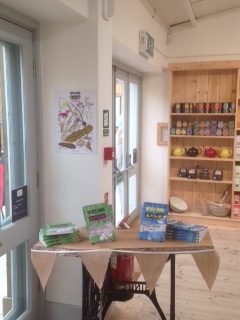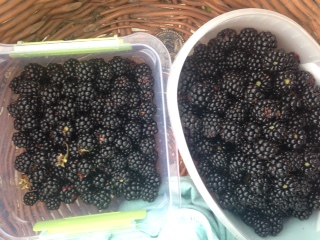 So where do I end? This is me signing out after a year… after taking you on a journey watching as the seasons change, a journey from forest to coast and hopefully whetting your appetite for enjoying wild food.
So where do I end? This is me signing out after a year… after taking you on a journey watching as the seasons change, a journey from forest to coast and hopefully whetting your appetite for enjoying wild food.
It has been quite a year – teaching a masterclass in foraging in Warwick, taking on new holiday complexes such as Tresarran in Herodsfoot, with a fantastic setting and abundant array of edible delights such as pignut, and Tredethick near Lostwithiel, catering for toddlers and taking my own little foraging helper with me (she was picking pineapple weed and handing it out to everyone last time and she isn’t yet 2!).
At the weekend I did my first foraging expedition on St Michael’s Mount where there are stunning seaweeds to identify along the causeway and a great chance for people to experience a side of the island that people aren’t normally allowed to explore. I treated my group to nettle and cheddar savoury scones with rock samphire pesto and pickled rock samphire, hogweed seed shortbread with rose petal jam, honeysuckle cordial and cooked, dried and candied sea spaghetti as well as other seaweeds to try.
 Foraging on the Mount has not been done before so I feel very privileged to do so and have a second one booked in on 20th August. If all goes well, I hope to collaborate with the chef to do a walk and feast… watch this space! Other achievements to mention from the past year have to be another fantastic year at Clovelly seaweed festival in June (if you have even the slightest interest in seaweeds or even happen to be near to Clovelly in June, you must go).
Foraging on the Mount has not been done before so I feel very privileged to do so and have a second one booked in on 20th August. If all goes well, I hope to collaborate with the chef to do a walk and feast… watch this space! Other achievements to mention from the past year have to be another fantastic year at Clovelly seaweed festival in June (if you have even the slightest interest in seaweeds or even happen to be near to Clovelly in June, you must go).
My seaweed posters went down well, with my hand-drawn British edible seaweeds, as did the seaweed fudge and savoury seaweed crackers. Heligan has been going well with my monthly walks and I was even invited to be the guest speaker for one of their Woodfired Canteen Feast Nights, which was a real treat. Oh and one more thing, Bruce Parry has written the foreword for my next foraging book, the autumn edition of Never Mind the Burdocks which I hope to publish this year!

One thing I mentioned in my first blog on here was that I couldn’t wait to see Lowen (my 21 month old) experience her first blackberry and say her first plant word. Well both have come true and more – her first experience trying a blackberry came last autumn and went very well… she was covered in blackberry juice!
 Her first plant name was daisy (‘daydee’) but she also attempts dandelion with an additional lion growl afterwards, she recognises my banana plants growing in the garden have the same name as the fruit (‘nana’), she picks all the wild strawberries from the garden (‘breeezzz’) whether they are ready or not, she has tried sorrel, daisies, ramsons, marsh samphire, sea purslane, saltbush, nettle scones, primroses, roses, various herbs, hogweed seed cakes, honeysuckle cordial… I forget the countless joyful experiences
Her first plant name was daisy (‘daydee’) but she also attempts dandelion with an additional lion growl afterwards, she recognises my banana plants growing in the garden have the same name as the fruit (‘nana’), she picks all the wild strawberries from the garden (‘breeezzz’) whether they are ready or not, she has tried sorrel, daisies, ramsons, marsh samphire, sea purslane, saltbush, nettle scones, primroses, roses, various herbs, hogweed seed cakes, honeysuckle cordial… I forget the countless joyful experiences
 I’ve witnessed. She says ‘HI!’ to every moving creature and wishes to kiss bees, she’s generous when she hands out plants for groups to try – she is an absolute joy, as her name suggests (‘Lowen’ means happy or joy in Cornish).
I’ve witnessed. She says ‘HI!’ to every moving creature and wishes to kiss bees, she’s generous when she hands out plants for groups to try – she is an absolute joy, as her name suggests (‘Lowen’ means happy or joy in Cornish).
I’d love to hear from you about your foraging experiences – are you a beginner? Have you been foraging your whole life? Foraging is for everyone as I have learnt over the years from the types of people who come on my walks. There is no ‘type’ of person who fits the category – I’ve had very young, very old and everyone in between, rich and poor, people wanting wild seasonal food for health and others for flavour, beginners to experts, male and female, singletons, couples and families, urbanites to country-dwellers. If you are a complete beginner, here are my top 10 favourite edibles that you must try.
- Wild garlic/ ramsons – so versatile, such a delicious intense garlic flavour
- Douglas fir – unexpected grapefruit and pine flavour
- Nettles – versatile, a great, healthy spinach substitute with fantastic flavour
- Black mustard – a hot, sweet kick like wasabi
- Blackberries – need I say more?
- Sea beet – a tough, evergreen coastal edible, naturally salty
- Marsh samphire – such a treat to find, succulent, salty
- Sloe – obviously great to make sloe gin, fantastic to reuse the gin soaked sloes for chocolate truffles
- Sea purslane – found along estuaries, a delicious salty sea veg
- Nori/laver – when dried it makes a delicious snack, addition to meals and goes great with chocolate brownies!
 Blackberry jam with damper bread
Blackberry jam with damper bread
This recipe is so simple that you can do this if you’re out camping. I had a go at this when we camped at one of my favourite spots on the estuaries around Truro (Carrick roads) and it worked well and made a great dessert to the grey mullet, cockles and sea beet we had for our main!
1 ½ cups self raising flour
1 tbsp honey
1 cup milk
Pinch of sea salt
Butter or oil to fry
Put the flour in a bowl and add the milk, honey and the pinch of salt. Put the oil or butter in a frying pan and on a medium heat and dollop tablespoonfuls of the mixture into the pan. Leave for a few minutes and when you can see the edges going golden, lift up slightly to check the colour and when ready, flip over to cook the other side.
Simple jam
1 cup blackberries
1 cup jam sugar
(a squeeze of lemon if you have it with you when you’re camping)
Pop the fruit and sugar in a saucepan with a splash of water and heat gently until the sugar has dissolved and the mixture starts to bubble (if you are adding lemon, add it at this stage). Stir it constantly and drop a little on a plate, leave it for a minute or two and push with your finger to see if it wrinkles. When it does, it is ready. Be careful as hot sugar seriously burns. Leave the jam to cool and set.
When it is all ready, serve the damper breads with the blackberry jam.

